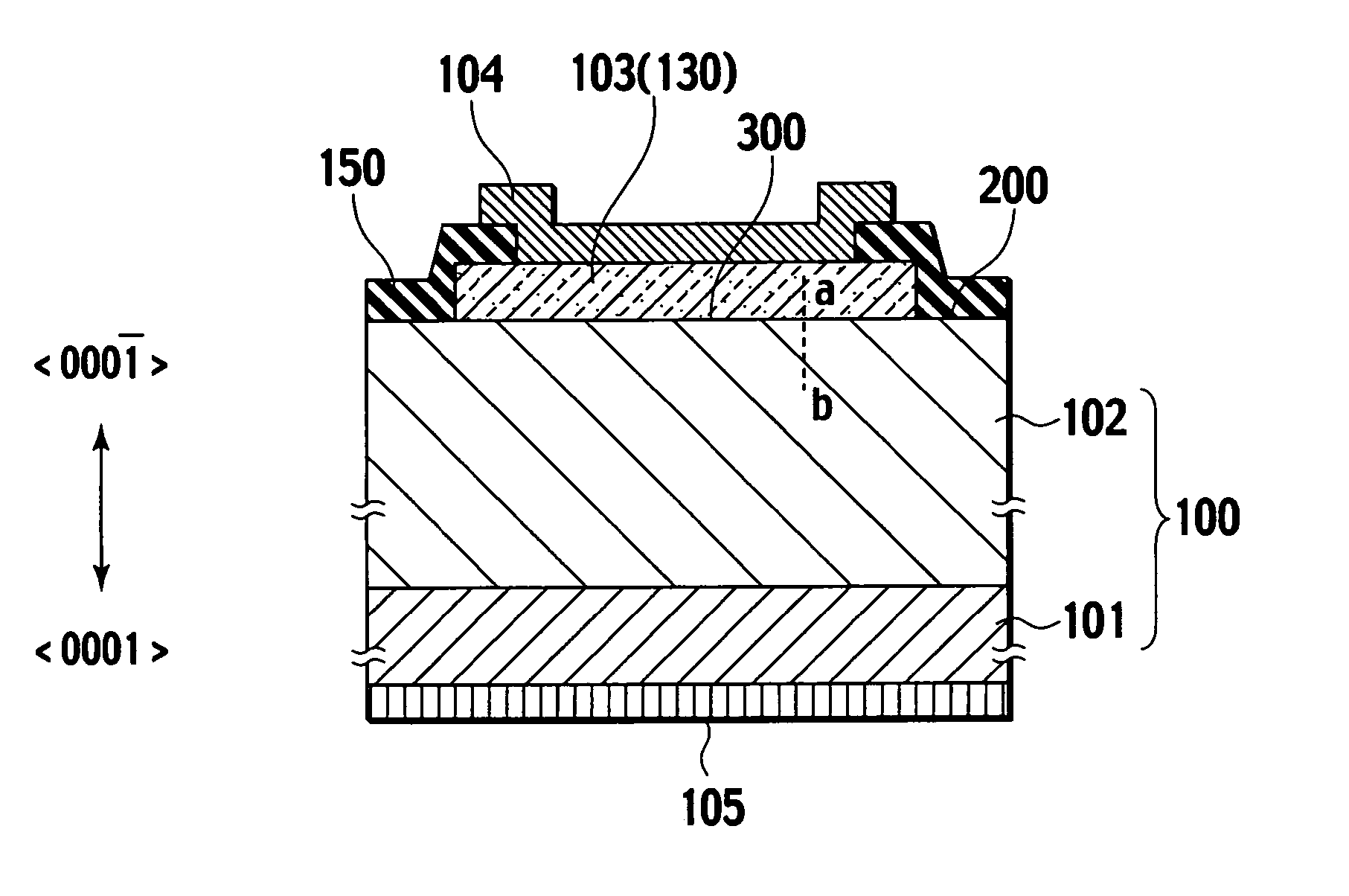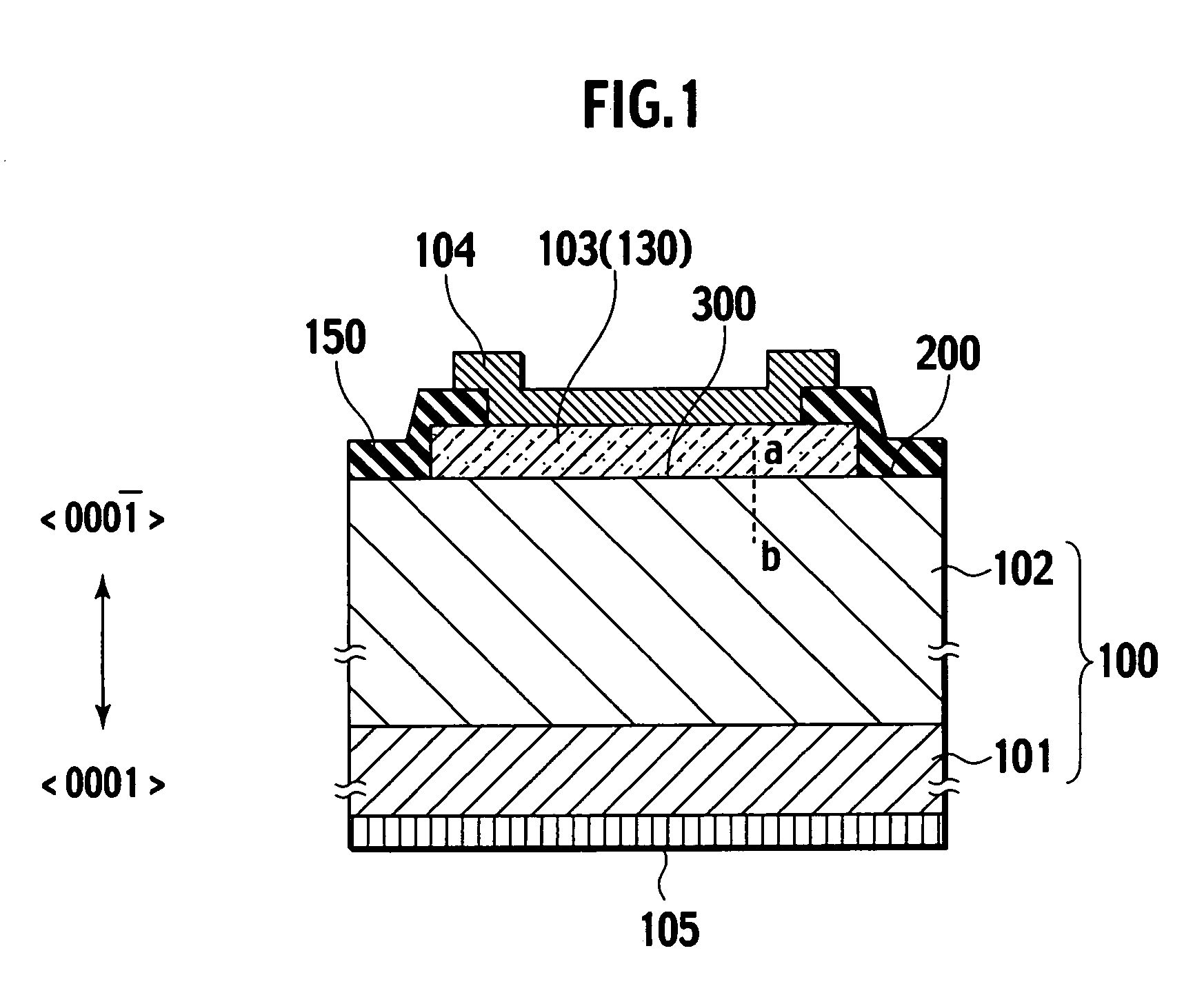Semiconductor device with heterojunction
a technology of semiconductor devices and heterojunctions, which is applied in the direction of semiconductor devices, basic electric elements, electrical appliances, etc., can solve the problems of increasing the manufacturing cost of semiconductor devices, and achieve the characteristics of heterojunctions, increase the manufacturing cost of semiconductor devices, and close the crystallinity of hetero-semiconductor regions
- Summary
- Abstract
- Description
- Claims
- Application Information
AI Technical Summary
Benefits of technology
Problems solved by technology
Method used
Image
Examples
first embodiment
[0027] First Embodiment
[0028]FIG. 1 is a sectional view showing a semiconductor device according to a first embodiment of the present invention. An n-type (first conductivity type) SiC substrate 101 and an n-type SiC epitaxial layer 102 whose impurity concentration is lower than that of the substrate 101 form an SiC semiconductor base 100. The SiC substrate 101 has, for example, a specific resistance of several to several hundreds of mΩ·cm and a thickness of several tens to several hundreds of μm. The SiC epitaxial layer 102 has, for example, an impurity concentration of 1×1015 to 1×1019 cm−3 and a thickness of several to several tens of μm. On the SiC epitaxial layer 102, a hetero-semiconductor region 103 is formed from an n-type silicon polycrystal film 130. The silicon polycrystal of the film 130 is a second semiconductor material that forms a heterojunction 300 with SiC of the epitaxial layer 102 and has a different band gap from SiC. The heterojunction 300 is formed on a {0001-...
second embodiment
[0044] Second Embodiment
[0045]FIG. 8 is a sectional view showing a semiconductor device according to a second embodiment of the present invention. An n-type (first conductivity type) SiC substrate 101 and an n-type SiC epitaxial layer 102 whose impurity concentration is lower than that of the substrate 101 form an SiC semiconductor base 100. The SiC substrate 101 has, for example, a specific resistance of several to several hundreds of mΩ·cm and a thickness of several tens to several hundreds of μm. The SiC epitaxial layer 102 has, for example, an impurity concentration of 1×1015 to 1×1019 cm−3 and a thickness of several to several tens of μm. At a predetermined location in the SiC epitaxial layer 102, a base region 112 is formed from a p-type (second conductivity type) SiC layer 140. At a predetermined location in the SiC epitaxial layer 102, a source region 111 is formed from an n-type SiC layer 141. Adjacent to the SiC epitaxial layer 102, base region 112, and source region 111, ...
third embodiment
[0051] Third Embodiment
[0052]FIG. 9 is a sectional view showing a semiconductor device according to a third embodiment of the present invention. An n-type SiC substrate 101 and an n-type SiC epitaxial layer 102 whose impurity concentration is lower than that of the substrate 101 form an SiC semiconductor base 100. The SiC substrate 101 has, for example, a specific resistance of several to several hundreds of mΩ·cm and a thickness of several tens to several hundreds of μm. The SiC epitaxial layer 102 has, for example, an impurity concentration of 1×1015 to 1×1019 cm−3 and a thickness of several to several tens of μm. On the SiC epitaxial layer 102, a hetero-semiconductor region 103 is formed from an n-type silicon polycrystal film 130 that is a second semiconductor material to form a heterojunction 300 with SiC and having a different band gap from SiC. The heterojunction 300 is formed on a {0001-} crystal face 200 of the SiC semiconductor base 100. At an interface of the heterojuncti...
PUM
 Login to View More
Login to View More Abstract
Description
Claims
Application Information
 Login to View More
Login to View More - R&D
- Intellectual Property
- Life Sciences
- Materials
- Tech Scout
- Unparalleled Data Quality
- Higher Quality Content
- 60% Fewer Hallucinations
Browse by: Latest US Patents, China's latest patents, Technical Efficacy Thesaurus, Application Domain, Technology Topic, Popular Technical Reports.
© 2025 PatSnap. All rights reserved.Legal|Privacy policy|Modern Slavery Act Transparency Statement|Sitemap|About US| Contact US: help@patsnap.com



